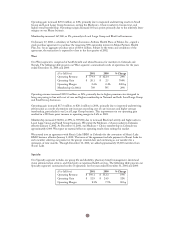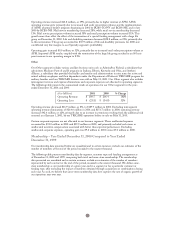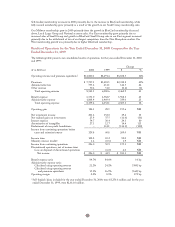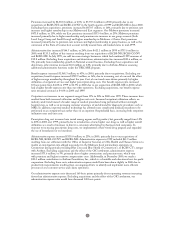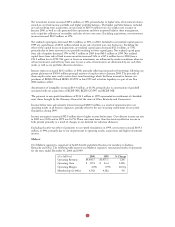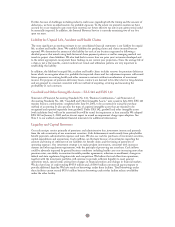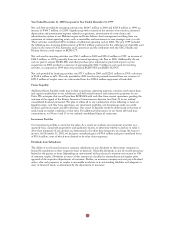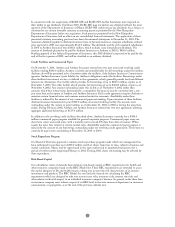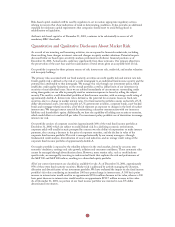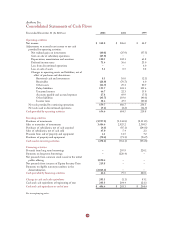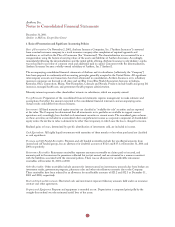Anthem Blue Cross 2001 Annual Report Download - page 37
Download and view the complete annual report
Please find page 37 of the 2001 Anthem Blue Cross annual report below. You can navigate through the pages in the report by either clicking on the pages listed below, or by using the keyword search tool below to find specific information within the annual report.
Further, because of challenges including industry-wide issues regarding both the timing and the amount of
deductions, we have recorded reserves for probable exposure. To the extent we prevail in matters we have
accrued for or are required to pay more than reserved, our future effective tax rate in any given period could
be materially impacted. In addition, the Internal Revenue Service is currently examining two of our five
open tax years.
Liability for Unpaid Life, Accident and Health Claims
The most significant accounting estimate in our consolidated financial statements is our liability for unpaid
life, accident and health claims. We establish liabilities for pending claims and claims incurred but not
reported. We determine the amount of this liability for each of our business segments by following a
detailed process that entails using both historical claim payment patterns as well as emerging medical cost
trends to project claim liabilities. We also look back to assess how our prior year’s estimates developed and
to the extent appropriate, incorporate those findings in our current year projections. Since the average life of
a claim is just a few months, current medical cost trends and utilization patterns are very important in
establishing this liability.
In addition, the liability for unpaid life, accident and health claims includes reserves for premium deficiency
losses which we recognize when it is probable that expected claims and loss adjustment expenses will exceed
future premiums on existing health and other insurance contracts without consideration of investment
income. For purposes of premium deficiency losses, contracts are deemed to be either short or long duration
and are grouped in a manner consistent with our method of acquiring, servicing and measuring the
profitability of such contracts.
Goodwill and Other Intangible Assets – FAS 141 and FAS 142
Statement of Financial Accounting Standards No. 141, “Business Combinations,” and Statement of
Accounting Standards No. 142, “Goodwill and Other Intangible Assets,” were issued in July 2001. FAS 141
requires business combinations completed after June 30, 2001, to be accounted for using the purchase
method of accounting. It also specifies the types of acquired intangible assets that are required to be
recognized and reported separately from goodwill. Under FAS 142, goodwill and other intangible assets
(with indefinite lives) will not be amortized but will be tested for impairment at least annually. We adopted
FAS 142 on January 1, 2002, and we do not expect to record an impairment charge upon adoption. See
Note 1 to our audited consolidated financial statements for additional information.
Liquidity and Capital Resources
Our cash receipts consist primarily of premiums and administrative fees, investment income and proceeds
from the sale or maturity of our investment securities. Cash disbursements result mainly from policyholder
benefit payments, administrative expenses and taxes. We also use cash for purchases of investment securities,
capital expenditures and acquisitions. Cash outflows can fluctuate because of uncertainties regarding the
amount and timing of settlement of our liabilities for benefit claims and the timing of payments of
operating expenses. Our investment strategy is to make prudent investments, consistent with insurance
statutes and other regulatory requirements, with the principle of preserving our asset base. Cash inflows
could be adversely impacted by general business conditions including health care costs increasing more than
premium rates, our ability to maintain favorable provider agreements, reduction in enrollment, changes in
federal and state regulation, litigation risks and competition. We believe that cash flow from operations,
together with the investment portfolio, will continue to provide sufficient liquidity to meet general
operations needs, special needs arising from changes in financial position and changes in financial markets.
We also have lines of credit totaling $935.0 million and a $300.0 million commercial paper program to
provide additional liquidity. We have made no borrowings under these facilities. Total borrowings under
these facilities cannot exceed $935.0 million because borrowing under either facility reduces availability
under the other facility.
35



